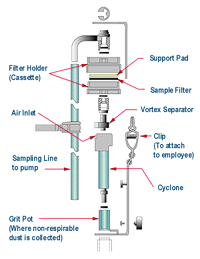|
 |
|
|
|
|
|
Measuring the Amount of Airborne Silica
|

|
|
Now that you suspect silica is being used and that it may be in the air, you need to know just how much is there. |
In order to find
out the silica concentration level, two things need to happen:
- Collection of a sample
- Laboratory analysis of that sample
|
| Cyclone Filter Assembly |
| Collecting an Air Sample |
A trained specialist, such as a certified industrial hygienist, will
use a combination device called a cyclone assembly and a sampling pump to trap tiny
respirable silica particles from the air in the work environment.
- The cyclone assembly and sampling pump will be placed on an employee, who will wear the
device throughout the work shift for up to 8 hours.
- All employees may be fitted with the sampling device or just a select few who are
closest to the silica source may be fitted. The industrial hygienist can help you
determine what will be most appropriate.
- The hygienist will return at the end of the sampling period to de-activate the sampling
pump and remove the filters to be sent for analysis.
Sampler's Note: For Dorr-Oliver nylon cyclones, the flowrate must be maintained
near 1.7 liters/minute to efficiently collect the respirable fraction. Any leaks
will cause a negative error Please refer to the
Cyclone Leak Test Procedure for more
information on proper cyclone operation. |
| Laboratory Analysis |
 Your main task here is to select a competent
laboratory that does quality work. This is critical to determining compliance with
the OSHA crystalline silica standard. The work from the previous step will be wasted
if the samples are mishandled or analyzed incorrectly.
Your main task here is to select a competent
laboratory that does quality work. This is critical to determining compliance with
the OSHA crystalline silica standard. The work from the previous step will be wasted
if the samples are mishandled or analyzed incorrectly.
You should ask the following questions and get positive answers before deciding to go with
a particular lab.
-
Can the laboratory describe the positives and negatives of the techniques they use
to analyze samples?
- Do they maintain accreditation with a recognized authority?
- Does the laboratory report the results in a format that is understandable and provides
all of the information required to perform the exposure calculations?
- Does the laboratory have a quality assurance program?
- Do they participate in a proficiency testing program for crystalline silica to assure
consensus and adequate performance?
- Do they analyze quality control samples to assure that their procedures are performing
correctly?
- Does the laboratory staff appear knowledgeable about your workplace operations,
including the other substances you use that could interfere?
These are just a few of the issues regarding the appropriateness of laboratories.
Refer to Laboratory Considerations for a more in-depth discussion.
Once you have selected a laboratory, the samples should be properly packaged then
shipped to the laboratory for analysis. The report from the laboratory can then be used to
compare with the legal limit.
|
|
For problems with accessibility in using figures and illustrations, please contact the OSHA Directorate of Technical Support and Emergency Management at (202) 693-2300.
|
|
|